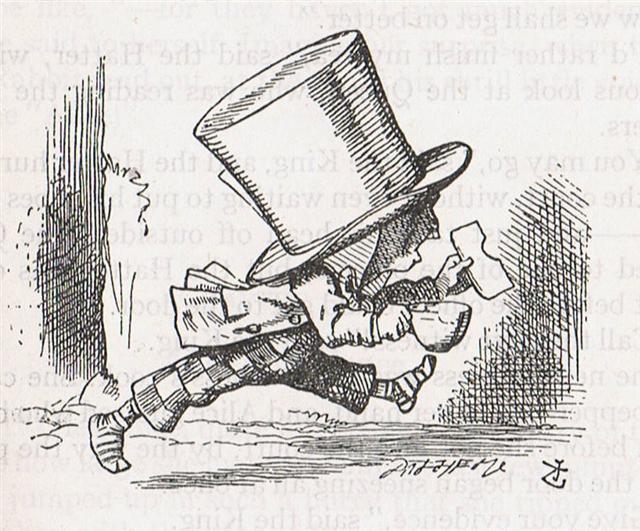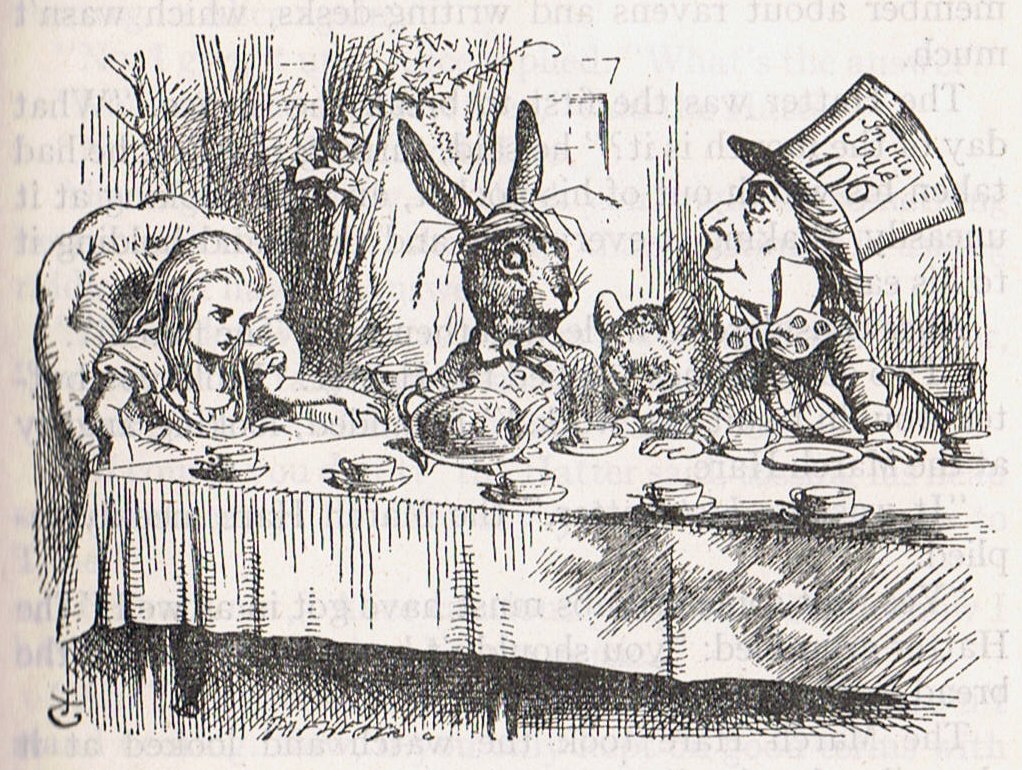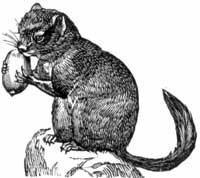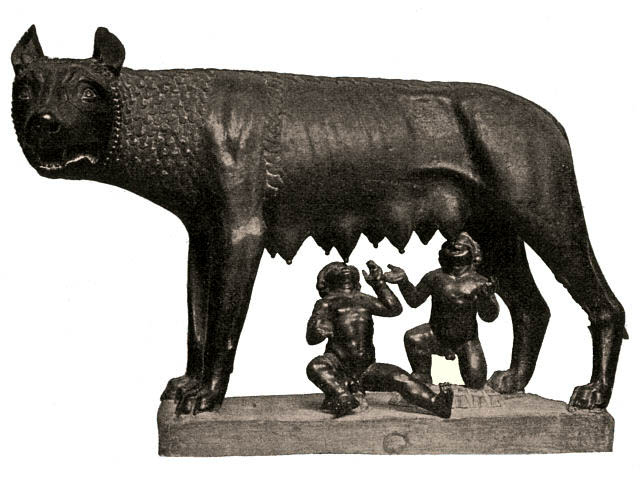|
TRANSLATIONS
The dormouse symbolizes the slow pace at solstice: dormouse ... small hibernating rodent, Myoxus ... it has been suggested that it was f. north. dial. dorm sleep; cf. the Du. names †slaepmuys, †slaepratte 'sleep-mouse', '-rat' ... (English Etymology) In the Swedish language sjusovare '7-sleeper' is a name with the same meaning. The slow pace of the sun is similar to how the story told by the Dormouse is proceeding. Another sign is the treacle, a liquid flowing extremely slowly. The Chesire Cat is in the midsummer tree, and looking right (future) he can see the Mad Hatter (in autumn), looking left he can see the March Hare (presumably inhabiting March). The Mad Hatter, then, ought to live in the rushing hour of autumn equinox:
The Hatter has his hat so low that he hardly can see where he is running - at fall darkness falls like a hat over the eyes. The Mad Hatter's Tea Party is telling about time. When the 'partitions' shift one step ahead, with the Mad Hatter at the front end, they move clockwise and Alice is trailing at far left:
Alice must be playing the part of midsummer sun. Focus, though, is on autumn. Considering the order between the 4 'members' as seen in the picture, time (sun) moves counterclockwise, because the dormouse must come after the Mad Hatter. Although the table is set for many, only 4 can take part if we think about a year and quarters. In the K calendar we have recently discovered how each quarter corresponds to 21 glyphs. In a way 20 equals 90, because 1 more is necessary to fill out time completely (4 * 91 = 364). If 20 equals 90, then a year will have 4 * 21 = 84 glyphs. However, there is 1 extra 'flame' for the year too. By adding 60 days to 360 we reach 420 at which point the cycles of sun and moon will come together at a great feast. By using the same concept of adding 1 to reach a happy doubly full cycle, we should not be surprised if we could find the number of glyphs in the K calendar to be 5 * 21 = 105:
29 is the black season. Henua ora is the recycling station. 4 quarters and 12 months maybe are alluded to in the line number and glyph number. If we add yet another 21 we reach 126 and have left the calendar behind us, transgressed with 1 glyph:
Is it possible to integrate into our table the '21-glyph' structure? The table has been constructed by using the 'end-of-period' glyphs as defining markers, but the '21-glyphs' are not of that type. Neither do they have a fixed glyph distance to their 'end-of-period' glyphs (or from their closest preceding such glyphs):
The number of glyphs structure in the table cannot easily 'swallow' the '21-glyph' structure.
Dormouse holding hazel-nut. (Wikipedia.) Another name for the dormouse in Swedish is hasselmus 'hazel-mouse':
The year might begin with the 'fall' of light or it might beging with the 'birth' of light. It is more or less an arbitrary decision where to cut the flow of time. The well of time marks new year, a sweet treacle-well, where 3 sisters live. The Raven (or Vulture as in ancient Egypt) is sitting in the hazel tree top (presumably waiting for sun to die), and I wonder what would happen if we located new year to winter solstice instead of to autumn equinox. In Hawaii they had another nut tree - the coconut. What bird was their carrion eater? The head of Balor was placed in the fork of the hazel tree after his death. The head or Ulu was planted near a spring of running water. The head of Balor was placed high, the head of Ulu was placed low - water collects in wells. Both Hawaii and Ireland lie north of the equator, and the reason for high contra low, therefore, ought to be due to Balor dying at summer solstice and Ulu at winter solstice. The reference to Mo'o confirms the latter statement; moko may be - I guess - be in opposition to mago. Remember the two sisters Vie Kena (light?) and Vie Moko (darkness?): ... Line 18 of the creation chant lists as the mythical parents of kena 'Vie Moko' and 'Vie Tea' (PH:520). The 'lizard woman' (vie moko) and her younger sister the 'booby woman' (vie kena) were considered the originators of tattooing (ME: 367-368). The 'white booby woman' (vie kena tea), together with other deities, protected the eggs of sea birds (RM:260). She might even be considered to be the female counterpart of the supreme god Makemake. In modern Hangaroa, vie kena tea is a term of endearment for a beloved wife whose well-rounded body and light skin is being praised ... Furthermore: ... The seven men looked around and saw that the turtle had crawled on land in the bay (of Hanga Hoonu). It was the spirit (kuhane) and not a turtle. It was a spirit that already had followed them. The seven laughed and went on their way. When the turtle saw that the seven went on their way, the turtle followed them out to sea ... (After the discovery of Anakena), the turtle also arrived (on the beach) of Hiro Moko ... (After Kuukuu's defeat), the turtle hurried away and returned to Hiva ... ... When the king had taken up residence in Anakena, in Hare Tupa Tuu, he said to the two men, 'Return to Hiva, to the (home)land, to the stone figure (moai maea) and bring the figure back. It was left out in the bay. Be careful when you get to the bay that the companion (mahaki), the Tautó, the king, is not broken!' Two men sailed in the canoe. There were no waves; the water was not turbulent (pari); there was no wind. The men sailed and landed in Hiva. When they had landed there, they saw that the figure (moai) was standing upright (maroa) out in the bay. They broke the neck of the figure, of Tautó. At that, the waves broke, the wind blew, the rain fell, the thunder rolled, and a meteorite fell on this land. Hotu Matua knew what had happened and lamented, 'Ah - broken is the neck of the figure, of the Tautó, of the king. You were not careful with the companion (mahaki).' (He) called to the servants (tangata vere taueve): 'Go down and see the companion, who was brought on land, on the beach, the beach of Hiro Moko.' The men went, arrived, and saw that (the figure) had landed on shore. They picked up the figure, the figure of Tautó. There was only a face (aringa) and a neck (ngao) (i.e., only the head of the figure was left). They picked it up, went to the king, and handed (the fragment) over to the king, to Hotu Matua. The king wept because the body (hakari), the legs (vae), and the arms (rima) had been (left) in Hiva, in the (home)land. The king lamented, '(So) this is how you came from Hiva, from the land where there is an abundance of food, where the lips ooze with the waste (of the abundant food) (kainga kai nui ngutu oone)!' ... Hiro Moko is 'the birthplace of the king's successor' (Bathel 2). ... It was an old Maori belief that a change of seasons was often facilitated by earthquakes. Ruau-moko, a god of the Underworld, was said to bring about changes of season, punctuating them with an earthquake. Or as another Maori saying summed up the matter, 'It is the Earth-mother shaking her breasts, and a sign of the change of season ... ... Maui at first assumed the form of a kiore, or rat, to enter the body of Hine. But tataeko, the little whitehead, said he would never succeed in that form. So he took the form of a toke, or earth-worm. But tiwaiwaka the fantail, who did not like worms, was against this. So Maui turned himself into a moko huruhuru, a kind of caterpillar that glistens. It was agreed that this looked best, and so Maui started forth, with comical movements ... In Polynesia they had Moko instead of Dormouse. I think 'dormouse' means 'door-mouse', the Opener of the Way (Upwaut) - alias the mother of Romulus and Remus (the twins):
... Alice was a good deal worse off than before, as the March Hare had just upsed the milk-jug into his plate ... |
||||||||||||||||||||||||||||||||||||||||||||||||||||||||||||||||||||||||||||||||||||||||||||||||||||||||





